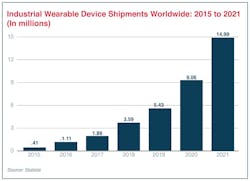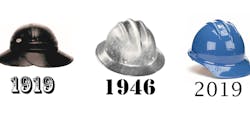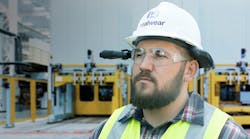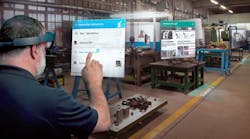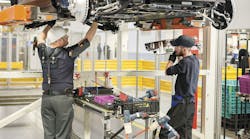Fashionably Great: Highlights from First-Ever Industrial Wearable Fashion Show
In what sounded like a prank but absolutely was not, on April 1, IndustryWeek put on the first-ever "Industrial Wearable Fashion Show" in Pittsburgh at our Manufacturing & Technology 2019 event. We had six models (five editors and good sport from one of the participating manufacturers), each representing one common industrial worker. There were more than 30 different items in the show, highlighting the latest in industrial wearable technology and PPE, the gloves, boots, and smartglasses that can yield some serious boosts to safety and KPIs.
The date itself was just one facet of why this show-within-a-show sounded like a gag, as industrial workers are way more concerned about how something works than how it looks (for good reason). It's why the consumer-based Google Glass failed but the Glass Enterprise Edition has found a solid user base at large manufacturers.
Several months back, when I mentioned the fashion show concept to Andy Lowery, the CEO of a leading industrial wearable manufacturer, RealWear, he chuckled and told me the idea was "very oxymoronic." He was mighty skeptical that the oil guys at drill sites—that his company provides intrinsically safe head-mounted tablets (the HMT-1Z1) to—aren't very worried about looking stylish. And he knows at least a bit how they think, as evidenced by huge deal Realwear made with Shell to deploy the HMT-1Z1 (via Honeywell) at 24 operational sites.
I agree with Lowery on that point, but manufacturers have a sense of fashion, too. It's not the same as the European waifs working the runway in a romper and moon boots. No, fashion in this sense means what employees need to wear to work better, the clothes you put on to uncover hidden efficiencies in the plant. The big question isn't what infinity scarf matches your favorite pair of chinchilla boots, but what PPE matches the hazards you face on a daily basis.
And that question gets more complex with the industrial wearable market about to pop off in a big way. MarketWatch projects the industrial wearable segment to grow from $1.5 in 2017 to $2.6 billion in 2023, a 73% jump, and that may be a conservative estimate. Forrester predicted that by 2025 14 million workers will use smart glasses and similar devices to increase performance. Combine that with what's happening with wearable sensors and exoskeletons and you have dozens of new options to choose from, and an exponentially growing amount of combinations uniquely suited to fit your operation.
That's why we believe developing a keen fashion sense now is of the utmost importance at the management level. If you wait too long to get familiar with what is available, you'll look absolutely outdated, and all those young workers you want to attract will go somewhere else. Sometimes seeing is believing, though, so we paired the latest in industrial wearable technology and PPE to show you where the bar is set for the modern worker. Ultimately, we hope the following gear, from the brand new like exoskeletons to the well-worn safety harnesses and boots, will you to reexamine your workforce's style and see if they could be due for an upgrade.









